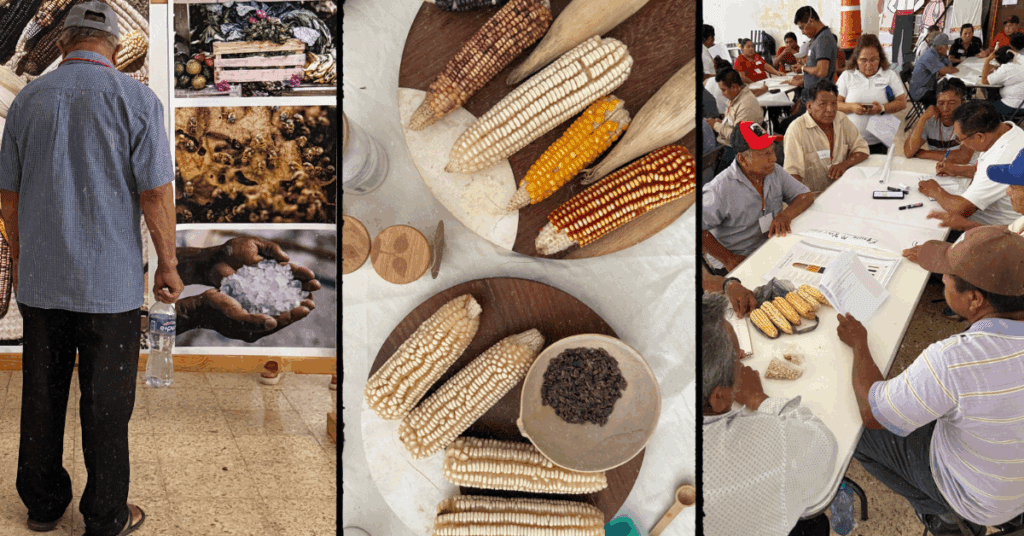Building the Future of the Milpa: Voices from the Field
We recently attended a powerful workshop held in Hopelchén, Campeche, organized by Traspatio Maya — the agricultural branch of the non-profit Fundación de Haciendas del Mundo Maya. The event brought together over 80 milpa farmers (milperos) who gathered to share their experiences, voice their concerns, and exchange ideas for strengthening and expanding the milpa system across Yucatán and neighboring regions.
The purpose of this gathering was to consolidate a committed community working to revalue and conserve the region’s biocultural heritage, placing milperos at the very heart of the value chain. Joining them were clients, civil society organizations, government representatives, academic institutions, and research centers — including INIFAP, CIMMyT, Pronatura, Educampo, CIAD, Muuch Kaambal, Cosechando Soberanía, and HEIFER — all collaborating to promote a social and solidarity economy and expand differentiated market access for surplus native maize, while maintaining conservation agriculture and food security safeguards.
This collective impact session not only celebrated the achievements of the 2024-2025 cycle, but also generated proposals for strengthening the system for the 2025-2026 cycle and beyond — ensuring that milperos continue to play a leading role at every stage of the process.
Among the proposals and needs expressed by the milperos were:
- Training and best practices in agriculture
- Greater gender inclusion
- Technological solutions for post-harvest handling (such as improved drying systems)
- Wider diffusion of native varieties
- Support for organic certification and solidarity certification systems
- Strengthening statewide visibility for what is being achieved
- More transparent pricing structures to reflect the true value of their work
- Continued exchange of seeds, knowledge, and experiences across communities
This open dialogue made it clear that while challenges remain, the solutions are within reach when everyone at the table works together.
What Is the Milpa?
The milpa is far more than a method of planting corn — it’s a living cultural system that has sustained the peoples of Mesoamerica for thousands of years. At its core, the milpa is a rotational intercropping system where corn (maize), beans, squash, and other crops grow together, each contributing to the health of the soil and the nourishment of the people.
The corn provides a stalk for the beans to climb; the beans fix nitrogen into the soil; the squash shades the earth to preserve moisture. This natural balance allows the land to remain fertile year after year, without the need for synthetic fertilizers or harmful pesticides.
But even beyond the science, the milpa is embedded in the Maya identity, woven into rituals, diets, and family traditions that carry spiritual and practical knowledge across generations.
Why Has the Milpa Been Disappearing?
Sadly, this brilliant system has faced enormous pressure in recent decades.
The introduction of transgenic (GMO) corn, industrial agriculture, and massive government subsidies for imported corn (primarily from the U.S.) have flooded the market with cheap, standardized grain, undercutting small farmers and pushing many away from the milpa.
Industrial corn may be cheaper to produce in the short term, but its costs are steep:
- Loss of native biodiversity
- Soil degradationDependency on chemical inputs
- Disconnection from ancestral knowledge
- Inferior nutritional value
In short, the true value of milpa-grown native maize — its superior nutrition, cultural significance, ecological balance, and food sovereignty — is not reflected in the market price. Many milperos struggle to survive in a system that doesn’t reward their knowledge or honor the true cost of sustainable farming.
A Movement to Rescue and Rebuild
Fortunately, not everyone has given up on the milpa. Programs like Milpa Sustentable, spearheaded by Fundación Haciendas del Mundo Maya and Traspatio Maya, are working hard to reverse the decline.
Rather than simply protecting the past, the Milpa Sustentable program aims to modernize and adapt the milpa system without sacrificing its soul — combining scientific support, fair trade access, and ancestral wisdom to create dignified livelihoods for milperos across the Yucatán Peninsula.
Key practices promoted through the program include:
- Use of biofertilizers and organic soil amendments
- Crop rotation to preserve fertility
- Use and preservation of native corn varieties
- Elimination of harmful pesticides and agrochemicals
- Post-harvest quality control to ensure food-grade standards
Most importantly, Milpa Sustentable provides a differentiated market where native corn can be sold at prices that reflect its true value — compensating farmers fairly for their labor and knowledge, rather than forcing them to compete with heavily subsidized industrial corn.
Why the Milpa Matters for Everyone
While this work directly benefits rural Yucatecan communities, it has global relevance. In a world facing soil depletion, food insecurity, climate instability, and rising chronic illness, the milpa represents a profoundly relevant model of agriculture that is:
- Regenerative
- Nutrient-dense
- Resilient to climate change
- Culturally rooted
- Economically dignified for small producers
The future of the milpa is not just a rural issue — it’s a conversation about what kind of food system we want for the 21st century. And right now, thanks to the vision and determination of the milperos and the collaborative efforts of organizations like Fundación Haciendas del Mundo Maya and Traspatio Maya, that future is still very much alive in Yucatán.




